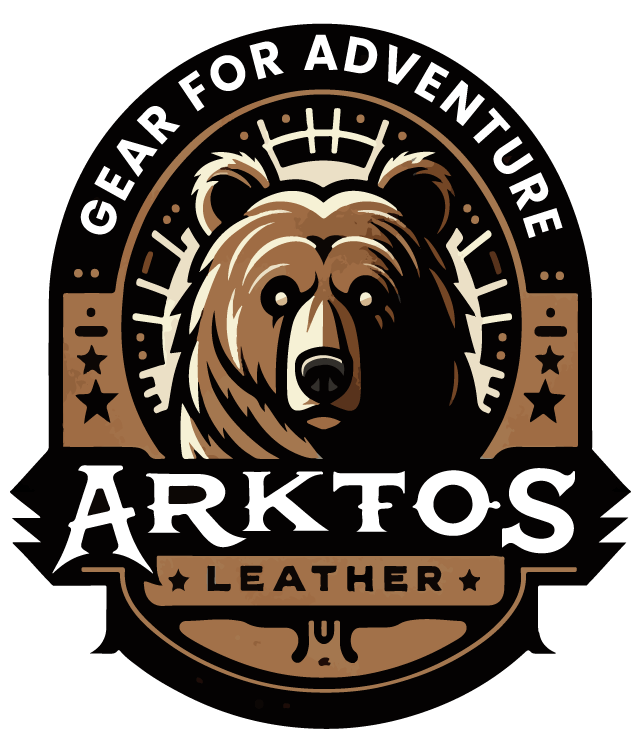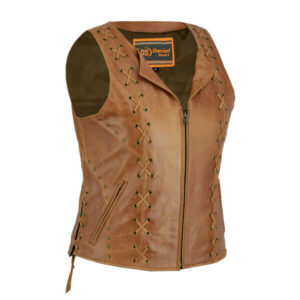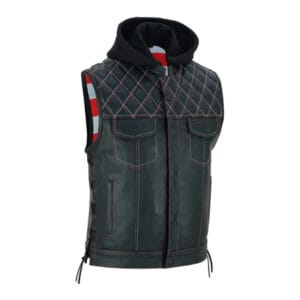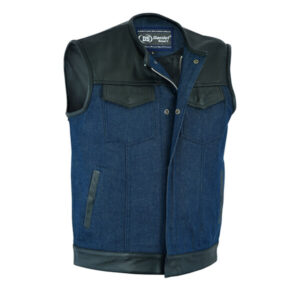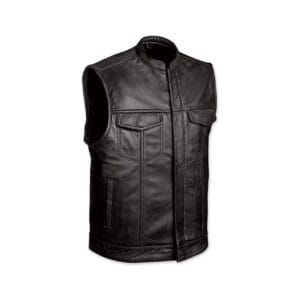Biker culture traces its roots back to the aftermath of World War II, when returning veterans found solace and camaraderie in the burgeoning motorcycle scene. These veterans, often disillusioned with mainstream society, formed tight-knit groups known as motorcycle clubs or MCs. These clubs provided a sense of belonging and brotherhood, with members bonding over their shared love of motorcycles and the open road.
Origins of the Term “Cut”
The term “cut” has its origins in the early days of biker culture, stemming from the practice of cutting off the sleeves of denim or leather jackets to create vests. This DIY approach to clothing customization was born out of necessity, as early riders sought practical garments that provided protection without restricting movement.
As motorcycle culture began to evolve in the post-war era, these makeshift vests became synonymous with the rebellious spirit of the biker lifestyle. They were often adorned with patches, pins, and insignias, serving as badges of honor for riders who embraced the freedom of the open road.
Men’s Quilted Honeycomb Stitch Cowhide Leather Biker Vest
Historical Context of Biker Culture
To understand the significance of the riding vest, it’s essential to explore the historical context of biker culture. Emerging in the years following World War II, biker culture was shaped by a generation of young men returning from war, seeking adventure and camaraderie in the burgeoning motorcycle scene.
These veterans, disillusioned with the constraints of mainstream society, found a sense of belonging in motorcycle clubs. These clubs provided a tight-knit community where members could bond over their shared love of motorcycles and the open road. In this context, the biker vest emerged as a symbol of identity and solidarity, marking riders as members of a unique subculture.
Evolution of Biker Apparel
Over the years, biker apparel has undergone significant evolution, reflecting changes in fashion, technology, and cultural norms. What began as practical garments designed for protection and warmth has evolved into a diverse array of styles and designs, each with its own unique symbolism and significance.
The biker vests, in particular, has seen numerous iterations over the decades. From the simple denim vests worn by early riders to the custom leather cuts adorned with intricate embroidery and patches seen today, biker vests have evolved alongside the culture they represent.
In addition to vests, other pieces of biker apparel have also evolved to meet the changing needs and tastes of riders. Leather motorcycle jackets, once worn primarily for protection, have become fashion statements in their own right, with styles ranging from classic to modern.
Similarly, biker boots, gloves, and helmets have evolved to incorporate new materials and technologies, offering riders both style and functionality on the road. Despite these changes, however, the underlying ethos of biker culture remains unchanged – a love of freedom, independence, and the open road.
Women’s Adjustable Brown Zippered Vest with Lacing Detail
Symbolism Behind the Term
The term “cut” carries profound symbolism within the biker community, representing far more than just a piece of clothing. At its core, the term embodies the spirit of individuality, rebellion, and solidarity that defines biker culture.
Identity and Brotherhood
For many riders, the motorcycle vest is more than just a garment; it’s a statement of identity and belonging. Adorned with patches, pins, and insignias, each vest tells a unique story, reflecting the wearer’s affiliations, achievements, and personal beliefs. In this sense, the biker vest serves as a canvas for self-expression, allowing riders to proudly display their membership in a particular club or community.
But beyond its role as a symbol of individual identity, the biker vest also fosters a sense of brotherhood and camaraderie among riders. Within the tight-knit world of motorcycle clubs, the vest acts as a unifying force, binding members together in a shared pursuit of freedom and adventure. Whether riding together on the open road or gathering at club events, the motorbike vest serves as a tangible reminder of the bonds that unite riders as brothers and sisters in arms.
Men’s Distressed Gray Sporty Cruiser Jacket
Pride and Loyalty
In addition to symbolizing identity and brotherhood, the motorcycling vest also embodies concepts of pride and loyalty within the biker community. For many riders, earning their club colors is a rite of passage, signifying their dedication to the club and its values. This sense of pride extends beyond the individual wearer to the club as a whole, with members proudly displaying their colors as a testament to their allegiance and loyalty.
Moreover, the bike riding vest serves as a symbol of resistance against mainstream society, challenging conventional norms and expectations. In a world that often seeks to impose conformity, the biker vest stands as a defiant assertion of individuality and freedom. It represents the unwavering commitment of riders to live life on their own terms, unapologetically and without compromise.
Components of a Biker Vest
The motorcycle vest, often referred to as a “cut” or “kutte,” is a canvas for self-expression, adorned with various components that reflect the wearer’s identity, affiliations, and personal style. From patches and emblems to intricate customization, each element of the biker vest contributes to its unique character and significance within the biker community.
Men’s Black Lightweight Leather Shirt
Patches and Emblems
Patches and emblems are perhaps the most iconic and recognizable components of a biker vest. These embroidered or printed insignias often feature the logos, symbols, and slogans of motorcycle clubs, indicating membership or affiliation with a particular group. In addition to club patches, riders may also adorn their vests with patches representing events they’ve attended, places they’ve visited, or causes they support. Each patch carries its own meaning and significance, contributing to the overall narrative conveyed by the vest.
Customization and Personalization
One of the defining features of the men’s biker vest is its customizability. Riders have the freedom to personalize their vests according to their tastes, preferences, and experiences. This can involve adding patches, pins, and emblems that reflect their interests, beliefs, and achievements. Additionally, many riders choose to customize their vests with unique embroidery, painting, or embellishments, further enhancing their individuality and style.
Customization extends beyond just the aesthetic aspects of the vest; it also encompasses practical considerations such as fit and functionality. Riders may add pockets, zippers, or other modifications to their vests to better suit their needs while riding. Some may even incorporate safety features such as reflective tape or armor inserts for added protection on the road.
Men’s Adjustable Diamond Stitch Hooded Leather Vest
The Role of Motorcycle Clubs
Motorcycle clubs play a central role in biker culture, serving as the backbone of the community and providing riders with a sense of belonging, camaraderie, and support. Within these clubs, club colors and insignias, as well as a hierarchical structure, play crucial roles in defining the identity and organization of the group.
Club Colors and Insignias
Club colors, often displayed on the back of a biker vest, are a visual representation of a motorcycle club’s identity and values. These colors typically consist of a large, embroidered patch depicting the club’s logo or emblem, along with smaller patches that may indicate the wearer’s rank or position within the club. Club colors serve as a source of pride and solidarity among club members, reinforcing their sense of belonging and camaraderie.
In addition to club colors, many motorcycle clubs also adopt specific insignias or symbols that hold special significance within the group. These symbols may represent the club’s history, values, or traditions, and are often displayed prominently on club paraphernalia such as vests, jackets, and motorcycles. By wearing these insignias, members affirm their allegiance to the club and its principles, while also signaling their membership to others within the biker community.
Men’s Single Back Panel Vintage Brown Leather Motorcycle Vest
Hierarchical Structure
Most motorcycle clubs adhere to a hierarchical structure that governs the organization and operations of the group. At the top of the hierarchy is the club’s leadership, which typically consists of a president, vice president, secretary, treasurer, and other officers responsible for overseeing club activities and decision-making.
Beneath the leadership are the club’s full-patch members, who have earned the right to wear the club’s colors and participate fully in club affairs. These members often have specific roles or responsibilities within the club, such as organizing events, recruiting new members, or representing the club in external matters.
Below full-patch members are probationary members, also known as prospects or hang-arounds, who are in the process of earning their club colors. Prospects undergo a period of probation during which they must prove their loyalty, dedication, and suitability for full membership. Once this probationary period is complete, prospects may be voted in as full-patch members, gaining full rights and privileges within the club.
Overall, the hierarchical structure of motorcycle clubs serves to maintain order, discipline, and cohesion within the group, while also providing members with opportunities for leadership, mentorship, and personal growth.
Men’s SOA Leather Biker Vest W/ USA Flag Lining
Differentiating Biker Vests from Jackets
In the world of biker culture, both vests and jackets play important roles as essential pieces of apparel. While they may appear similar at first glance, there are distinct differences between the two in terms of functionality, design, and cultural significance.
Functionality and Design
The primary difference between vests and jackets lies in their functionality and design. Jackets, typically made from leather or heavy-duty textiles, are designed to provide riders with protection from the elements, including wind, rain, and road debris. They often feature features such as zippers, pockets, and adjustable cuffs for added comfort and convenience.
Vests, on the other hand, are sleeveless garments that are more lightweight and less protective than jackets. While they may offer some degree of warmth and insulation, their primary purpose is not to shield riders from the elements but rather to serve as a canvas for self-expression and customization. Vests are often worn over other layers of clothing, allowing riders to display patches, emblems, and insignias that represent their affiliations, achievements, and personal style.
Cultural and Social Distinctions
Beyond their functional differences, vests and jackets also carry distinct cultural and social connotations within the biker community. Jackets, with their association with protection and practicality, are often worn by riders during long rides or inclement weather conditions. They symbolize a commitment to safety and preparedness, reflecting the responsible and pragmatic side of biker culture.
Vests, on the other hand, are more closely associated with the social and cultural aspects of biker culture. They serve as a means of identifying membership in a particular motorcycle club or affiliation with a specific group or subculture. Vests are often adorned with patches, emblems, and insignias that carry deep personal and collective meaning, signaling the wearer’s allegiance, achievements, and values within the biker community.
Men’s Black Leather Scooter Jacket With Reflective Skulls
Biker Vest Traditions
Bike riding vest traditions are an integral part of motorcycle club culture, encompassing ceremonial aspects, rituals, and customs that hold deep meaning and significance for club members. These traditions serve to reinforce the bonds of brotherhood, honor the club’s history and heritage, and mark important milestones in the lives of riders.
Ceremonial Aspects
One of the most significant motorcycle vest traditions is the ceremony surrounding the awarding of club colors to new members. This ceremony, known as a “patching-in” or “vesting-in,” is a rite of passage in which prospective members are formally accepted into the club and granted the privilege of wearing the club’s colors. The ceremony typically involves a series of rituals and customs, including the presentation of the club’s colors, the recitation of club oaths or pledges, and the exchange of symbolic tokens or gifts.
In addition to patching-in ceremonies, biker clubs may also observe other ceremonial aspects related to the wearing and display of club colors. For example, some clubs have specific protocols for how and when colors should be worn, as well as rules governing the handling and care of club paraphernalia such as vests and patches. These traditions help to instill a sense of pride, honor, and respect for the club’s colors among its members.
Rituals and Customs
Beyond formal ceremonies, biker clubs often have a rich tapestry of rituals and customs that are observed as part of club life. These rituals may vary widely from club to club but often serve to reinforce the club’s values, traditions, and sense of camaraderie. Examples of biker vest traditions may include:
- Annual or semi-annual “runs” or rides to commemorate significant events or milestones in the club’s history.
- Memorial rides or ceremonies to honor fallen members or pay tribute to those who have passed away.
- Club meetings or gatherings where members come together to discuss club business, plan events, and socialize with fellow riders.
- Customization sessions where members gather to add patches, pins, and other adornments to their vests, often accompanied by music, food, and camaraderie.
These rituals and customs help to foster a sense of belonging and identity within the club, creating bonds that extend beyond mere membership to form a tight-knit brotherhood of riders.
Men’s Leather/Denim Combo Biker Vest Blue
Legal Implications
The world of biker apparel is not without its legal implications, as regulations regarding biker apparel, as well as legal battles over symbols and designs, have become increasingly prevalent in recent years. From concerns about safety and trademark infringement to debates over freedom of expression and cultural appropriation, the legal landscape surrounding biker apparel is complex and multifaceted.
Regulations Regarding Biker Apparel
One of the primary legal concerns surrounding biker apparel is safety regulations. In many jurisdictions, there are strict regulations governing the design and construction of motorcycle gear, including vests, jackets, and helmets. These regulations are intended to ensure the safety and protection of riders on the road, by mandating features such as impact-resistant materials, reflective elements, and secure fastenings.
Additionally, there may be regulations regarding the use of certain symbols or insignias on biker apparel. For example, some jurisdictions have laws prohibiting the display of gang-related symbols or imagery, due to concerns about public safety and organized crime. Similarly, there may be restrictions on the use of copyrighted or trademarked logos and designs, to prevent unauthorized use and protect the rights of intellectual property holders.
Mens Black Leather SOA Anarchy Outlaw Biker Vest
Legal Battles Over Symbols and Designs
In addition to regulatory concerns, legal battles over symbols and designs have become increasingly common within the world of biker apparel. These battles may arise from disputes over trademark infringement, as motorcycle clubs and apparel manufacturers seek to protect their logos and insignias from unauthorized use by third parties. Similarly, there may be disputes over the use of culturally significant symbols or imagery, as different groups seek to assert ownership and control over their cultural heritage.
These legal battles can be complex and contentious, often involving issues of intellectual property law, freedom of expression, and cultural sensitivity. In some cases, disputes may escalate to litigation, with parties seeking injunctions, damages, or other legal remedies to protect their interests.
Conclusion
In conclusion, biker culture is a vibrant tapestry woven with tradition, identity, and camaraderie. From the iconic biker vest to the rituals of motorcycle clubs, it embodies freedom and rebellion.
As we navigate the legal complexities and celebrate the rich heritage of biker apparel, let’s cherish the bonds forged on the open road. Together, let’s honor the spirit of individuality and adventure that defines biker culture.
Ride on, united by the thrill of the ride and the shared passion for the open highway.
